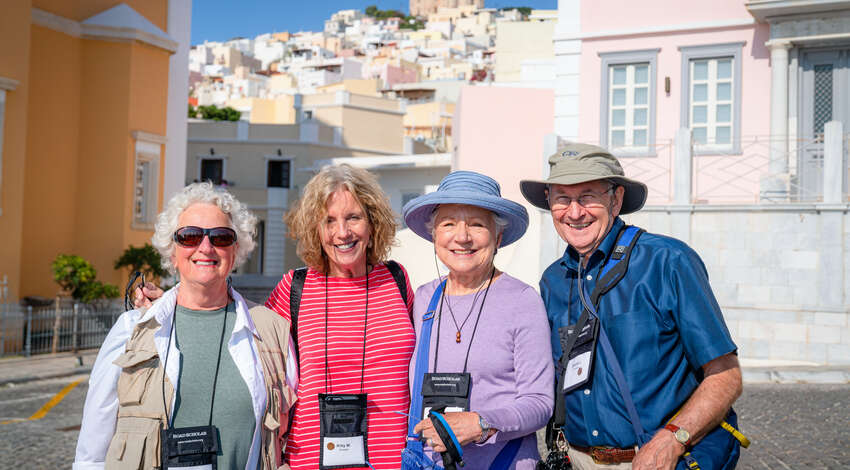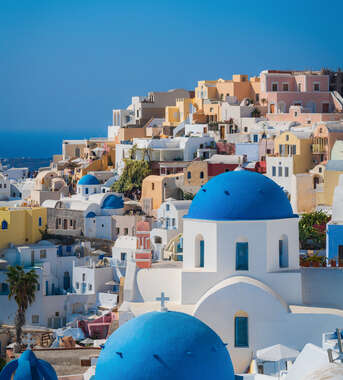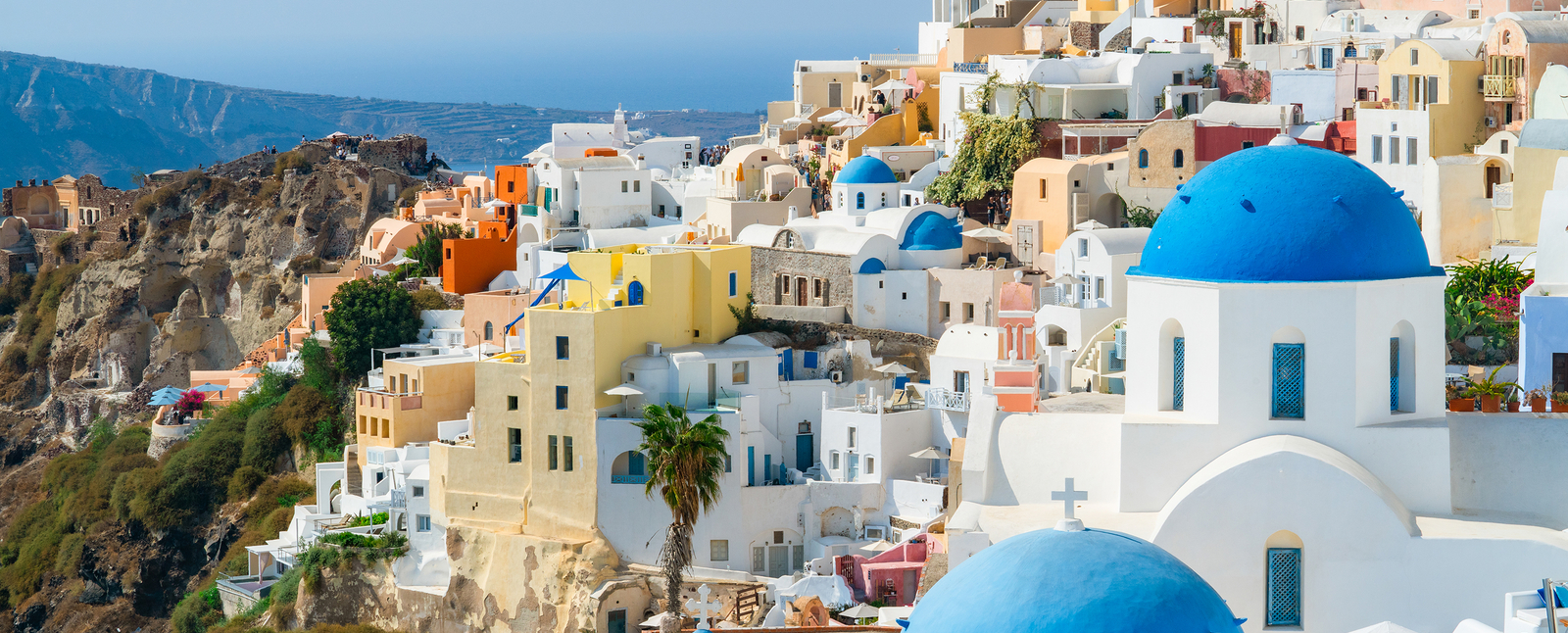The Best Time to Visit Greece: A Seasonal Guide
-
Optimal Weather: Late spring (May-June) and early fall (Sept-Oct) offer mild temperatures, fewer crowds, and ideal conditions for sightseeing. Fall also boasts warm seas for swimming.
-
Cultural Immersion: May to September is prime for festivals and events like Orthodox Easter, the Athens & Epidaurus Festival, and local panigiri.
-
Santorini Specifics: Visit late April-early June or Sept-mid-Oct for pleasant weather, fewer crowds, and warm waters in the fall.
-
Planning: Align your visit with your goals, consider your travel style, and pack appropriately for the season.

Planning a trip to Greece? The time of year you visit can shape your entire experience, as each season, from its weather and crowds to the activities available, varies throughout the year. That said, the best time to visit Greece depends on your travel goals and what you’re looking to get out of your Greek experience.
Whether you’re dreaming of sun-soaked islands, exploring ancient ruins or savoring fresh Mediterranean meals by the sea, this seasonal guide breaks down the best time of year to visit Greece based on what exactly you’re looking to get out of your trip. From quiet spring escapes to vibrant summer escapades and cozy fall getaways, use this guide to plan a vacation in Greece based on your style.
The Best Time of Year to Visit Greece for Perfect Weather
If your primary goal when you visit Greece is to enjoy clear skies and comfortable temperatures, the best times to go are either late spring, from May to June, or early fall, from September to October. These shoulder seasons offer the ideal mix of warm, sunny days and cooler evenings, which are excellent for sightseeing, outdoor dining and exploring without the intensity of the summer sun beating down on you.
Greece tours during late spring are perfect for a wide range of reasons. What makes it the best time to go to Greece?
-
Mild, pleasant temperatures: Between May and June, the temperatures in Greece are comfortable, typically ranging from the low 70s to the mid-80s°F (21–29°C), making it an excellent time for walking tours, visits to ancient sites like famous Greek temples or light hiking.
-
Blooming landscapes: Greece’s scenery comes to life after the cold temperatures of winter dissipate, especially in the countryside in areas such as the Peloponnese, Crete and mainland mountain villages.
-
Fewer crowds: Tourists haven’t arrived in full force in the spring, making this time of year the perfect opportunity to explore historic sites and top attractions without bumping shoulders with other visitors. Enjoy sites like the Acropolis or Santorini’s caldera views with more breathing room.
-
Perfect opportunity for island hopping: During the spring, ferries continue to run regularly, but ports and villages aren’t yet packed. While water temperatures may still be cool, some days are warm enough for a dip in the Mediterranean. Refer to our small ship cruises guide to learn more about what to expect on light voyages aboard small vessels, such as those that transport you between Greek islands like Rhodes, Mykonos and Corfu.
If you find yourself busy during the spring, the fall is another “best time to visit Greece.” Here’s what autumn in Greece offers its visitors:
-
Warm days and cool nights: September in Greece feels like a gentler version of summer, with temperatures in the mid-70s to low 80s°F (21–28°C), without the intense sweat-inducing heat.
-
Comfortable swimming temperatures: While the waters of the Mediterranean are often cool in the spring, after a full summer of sunshine, the water is perfect for beach days, especially on islands like Crete, Milos and Paros.
-
Harvest season: Fall in Greece brings local festivals and seasonal produce, such as fresh figs, grapes, olives and wines, making it an excellent time for food lovers and wine aficionados to visit.
-
Fewer crowds: Similar to spring, autumn in Greece sees fewer crowds as students return to school and summer vacations come to an end. This makes popular spots easier to explore, with prices for accommodations and activities often dropping.
Whether you’re exploring ancient ruins, cruising the islands, relaxing in a coastal town or taking scenic walks, spring and fall offer the best times of year to visit Greece, suitable for all travel preferences. The heat isn’t extreme, either, making the shoulder seasons perfect for seniors who prefer a more comfortable temperature and pace.

Syros, Greece
Best Time to Go to Greece for Cultural Events and Festivals
Beyond its stunning scenery, Greece offers rich cultural experiences, from living traditions to vibrant performances. Timing your vacation in Greece around local events and festivals can make your trip truly unforgettable. The best time to visit Greece for cultural events and festivals is from late spring to early fall, particularly from May through September. Here are some of the immersive events you can catch during this time of year:
-
Orthodox Easter (varies by year): The most important religious celebration in Greece is Orthodox Easter, often observed in April or early May, where towns and villages come alive with processions, fireworks, music and traditional food. Visiting during this time offers an intimate view into Greek faith, family life and community spirit.
-
May Day: On the first of May, Greeks celebrate spring and nature, especially in villages and the countryside, where floral wreaths are hung on doors and locals gather for music and dance.
-
Local village festivals: Throughout spring, many local villages celebrate their patron saints with open-air feasts, live music and dancing, known as panigiri, that often last late into the night.
-
Athens and Epidaurus Festival: One of Europe’s top summer festivals is the Athens and Epidaurus Festival, where classic Greek drama, opera, ballet, and modern performances are presented, with some taking place in the iconic and ancient Theatre of Epidaurus, an open-air venue renowned for its incredible acoustics.
-
Rockwave Festival: For contemporary music lovers, this annual rock festival in July draws international and Greek acts to Athens.
-
Naxos Festival & Rhodes Festival: During the summer, these islands host festivals featuring live theater, concerts, art exhibits, and informal gatherings that welcome all visitors.
-
Grape harvest celebrations: Wine-producing regions like Crete and Peloponnese mark the grape harvest with tastings, tours and traditional food during the fall, with some wineries hosting open events.
-
Athens International Film Festival: Held in September, this event showcases films from around the world, attracting a creative crowd.
While major cities like Athens and Thessaloniki host large-scale events, many smaller towns and islands often have intimate, community-driven events and festivals where visitors can join locals in dancing, dining and celebrating shared traditions.
If you want to experience the living culture of Greece, not just its ancient past, consider planning your trip between May and September. As the best time to go to Greece, this time of year boasts religious holidays, seaside concerts and food festivals where you can feel the country’s rhythm, flavors and soul.
When to Visit Greece for a Perfect Santorini Vacation
Interested in Mediterranean tours to places like the picturesque Santorini? The best time of year to visit Greece and one of its most iconic destinations is from late April to early June or from September to mid-October.
Spring into island life from late April to early June, where temperatures in Santorini sit comfortably in the 70s°F (21–25°C), perfect for walking the caldera paths or lounging by the beach after stopping at a seaside café.
With fewer tourists, the island comes to life after its quiet winter, while still remaining peaceful compared to the high season in the midst of summer. During this time, you can visit Oia and Fira without battling large cruise ship crowds, as well as enjoy restaurants and shops that are back in full swing.
From September to mid-October, you can enjoy Santorini’s summer glow with fewer people. The sea is still warm for swimming after being heated by months of summer sun, whether taking a dip at the beach or cannonballing off a boat. And, warm days are followed by cool evenings that are ideal for sunset dinners and evening strolls. From thinner crowds to more affordable accommodations and a relaxed, romantic vibe, the best time to visit Santorini is late spring or early fall.
Tips for Planning Your Dream Vacation in Greece
When embarking on European tours to places like Greece, there are several key tips to keep in mind to ensure a smooth, comfortable and safe trip. Keep these traveling planning tips in mind for when you visit Greece:
-
Choose the right season: The best time to visit Greece varies depending on the traveler. Late spring and early fall are great for comfortable weather and fewer crowds. Winter is quieter with smaller crowds and great prices, but some islands and tourist spots may be closed for the season. In contrast, summer is the hottest and busiest time of year, especially on islands like Santorini and Mykonos.
-
Decide on a travel style: Greece offers various ways to explore. Guided group tours handle logistics and provide great cultural insights, while solo travel offers independence and flexibility to explore on your own terms. Or, you can consider a private tour or small group program with friends and family.
-
Pack smart: Greece is casual yet stylish, so pack accordingly with comfortable walking shoes, layers for cool evenings, sun protection like a hat and sunglasses and a swimsuit to enjoy the refreshing waters.
Make the most of your Greek travel with Road Scholar. We offer a wide range of experiential learning programs that create an immersive experience. Learn about the ancient ruins in Athens, enjoy cultural experiences like a Mediterranean cooking class or go island hopping to soak up the sun.



